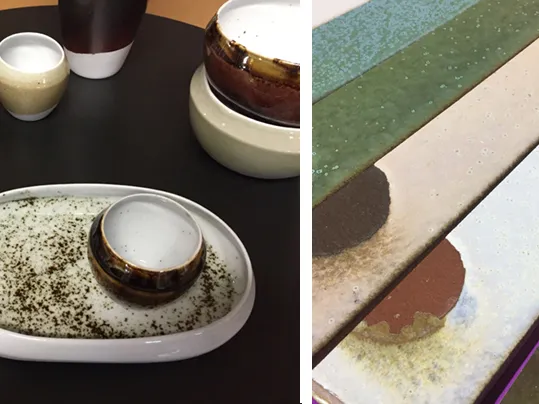Trends & Design

Smart solutions for small scale living, modular systems, product designs that can be reassembled, a revaluation of raw materials or the development of new sustainable materials. Dutch Design Week 2018 was all about exploring new possibilities to reduce our footprint. Designers, scientists and the industry collaborate and try to find new solutions for a more sustainable way of living.
In this context our Linoleum was embraced as a sustainable CO2 neutral product. DAE graduates, emerging product labels and design collectives either integrated or used Linoleum as starting point for the development of exciting new applications and brilliant material innovations.
The project 'Buitenpost' is a collaboration between Chris Collaris Architects and the designer collective Dutch Invertuals commissioned by the Dutch holiday-housing company 'Droomparken'.
It is a proposal for a series of compact office unites located in a summer holiday park and in the context of a rural environment. A comfortable beautifully designed compact space where you, together or alone, can dream, work or relax.
Forbo Marmoleum decibel has been selected as an ideal floorcovering in this context.
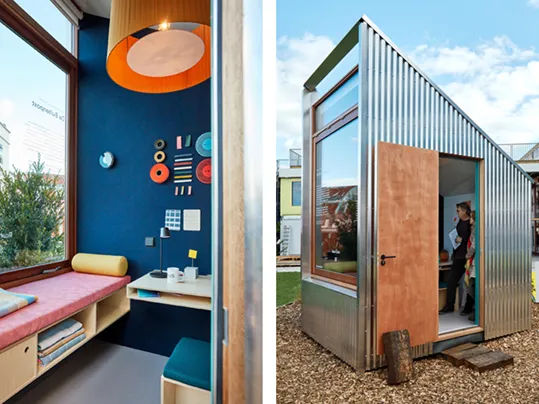
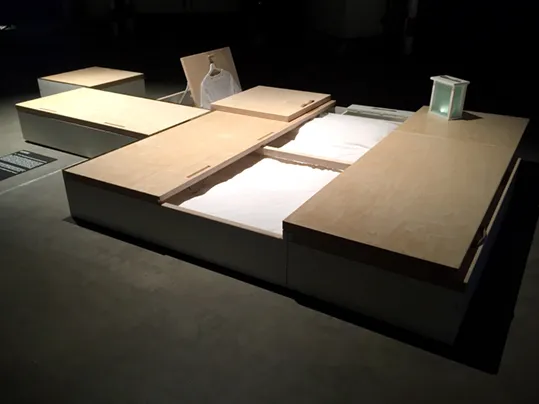
With her project MoreFloor the Eindhoven Design Academy graduate Juul de Bruijn offers a smart solution for the emerging scarcity of urban living space. Her design enables the user to transform the sleeping area into a practical space during daytime. Elevated wooden floor elements provide storage beneath their lids and clears away furniture, such as the bed, that sits unused for large parts of the day. 'Work and Play on the floor during the day and when you get tired simply open the floor and snuggle up'.
Most often, the digital layer of smart homes remains invisibly in the background - impalpable and distant. But what would happen if it emerged from the screens? In the installation "Within Touching Distance" by DAE graduate Jonas Althaus, visitors are cared for by a set of animated curtains, each with its own characteristics. These phygital hosts float over a smart floor, made of Marmoleum Concrete linoleum, a material that reveals a rich texture at close sight, bridging sensual materiality with the digital landscape.
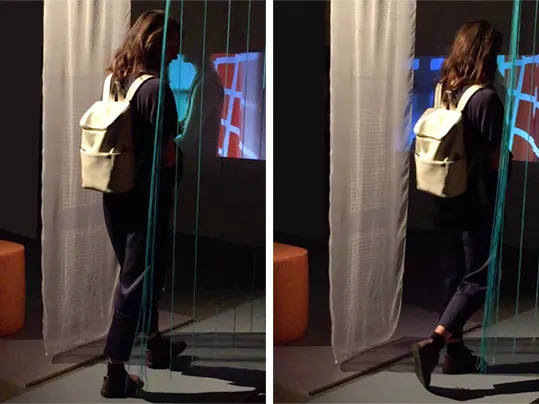
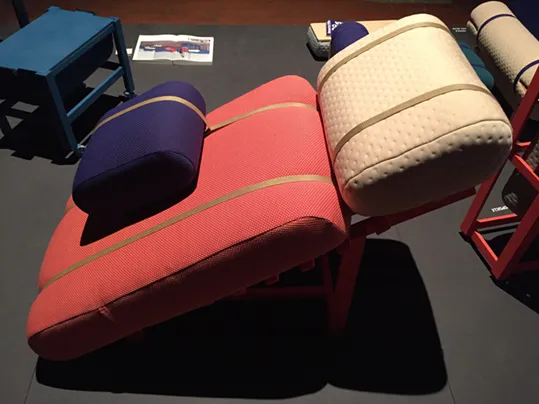
Geoffrey Pascal, a DAE graduate, created a collection of future office furniture that responds to the growing number of people working at home in their beds. With his design he aims to imitate the laid back postures when working in bed. With adjustable separate foam pieces the user can easily adapt the posture for the task at hand. Geoffrey based his design on Nasa's Research on the ideal resting position of an Astronaut (Neutral body posture) a program developed to safe guard the health of astronauts in zero-gravity.
With 'Building the local' DEA graduate Ellie Birkhead
tries to find ways to rebuild the endangered ecosystem of local manufacturing. Globalization has spelt the end of many small-scale industries. Ellie introduces waste products, spent grain from breweries, recycled glass from pubs, waste from farms, from neighboring industries into the brickmaking process. 'Building the Local' enhances the materiality of the traditional brick through new industrial connections, in an effort to rebuild the endangered ecosystem of local manufacture.
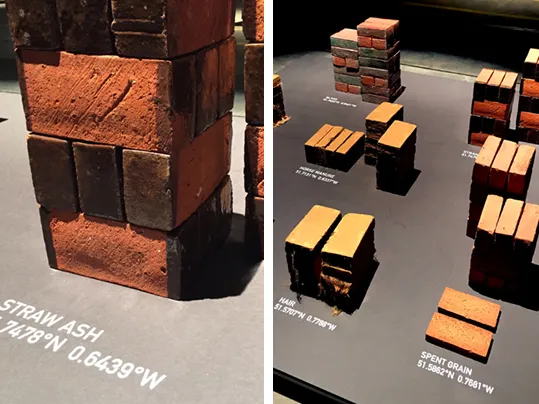
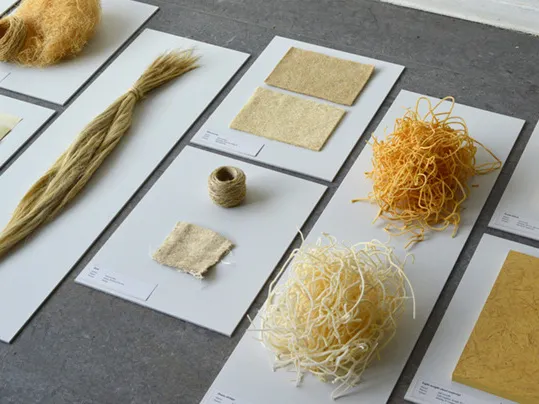
The project Medulla demonstrates an impressive material research into new application possibilities of the Soft rush of an usually unwanted weed. The DAE cum laude graduate Don Kwaning transformed it into materials like paper, textile, foam & a construction material.
The pith of the soft rush is a foam. This material possesses lightweight, shock-resistant and insulating proper- ties that make it suitable as ecological packaging material. In addition to that, the foamy pith can be compressed in different densities, which also makes it suitable as a lightweight sheet material that can be applied in furniture.
For his second graduate project Don Kwaning developed a so called Lino Leather, a linoleum based material that imitates the appearence of leather.
In close collaboration with the Forbo Flooring Pilot factory Don created two different versions of his idea for this vegetal leather.
The first prototype is a thick 3D structure that ressembles Rumen leather, which is usually made from a cow's stomach.The second reminds of Saddle leather and is based on a sandwich of two layers of pigment-free linoleum with a textile layer pressed in between.
Kwaning specialises in finding new uses for natural materials and aspires to teamed up with more manufacturer to continue his research.

Over the past decade the NMA has proven to be an important catalyst for innovative design research. The New Material Award offers a platform to a generation of designers who dare to ask fundamental questions about industrial production processes and natural growth, waste flows and residual materials. With their speculative projects, the designers visualize an alternative, optimistic view of natural resources and the materials of the future. This year's winner is Studio Klarenbeek & Dros and Atelier Luma with their Algae Lab Luma project.
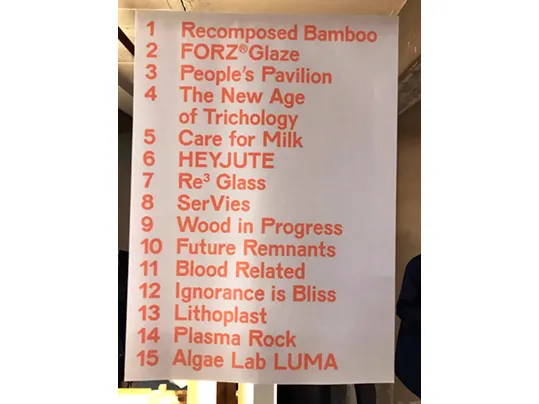
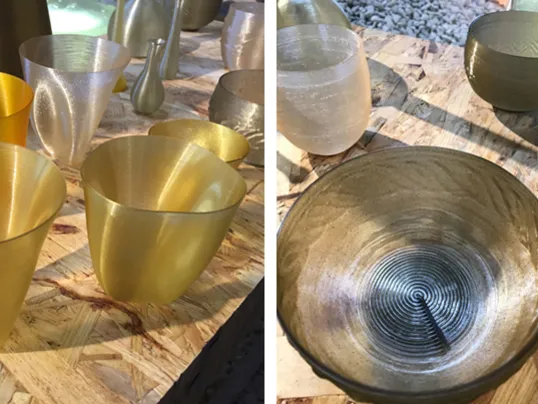
Is it possible to replace fossil raw materials in the production of polymers? It was one of the questions Maartje Dros and Eric Klarenbeek were asking themselves. With Algae Lab Luma they explore the possibilities of sustainable material and product development based on locally grown algae. The Lab is experimenting with the production of a granulate, suitable for large-scale industrial use. It can be used to create a filament based on algae, so that this biopolymer is ready for 3D printing.
'Ignorance is bliss' is an ongoing research by Agne Kucerenkaite for metal waste and their coloring properties. Kucerenkaite came up with the idea when investigating wheter metal waste might be an alternative to the virgin metal usually used to make pigments for glazes. For her experiments she collected soil from six different locations. These included samples from a zinc factory in Budel, a soil remediation company in Weert, and waste from companies which clean drinking water.
